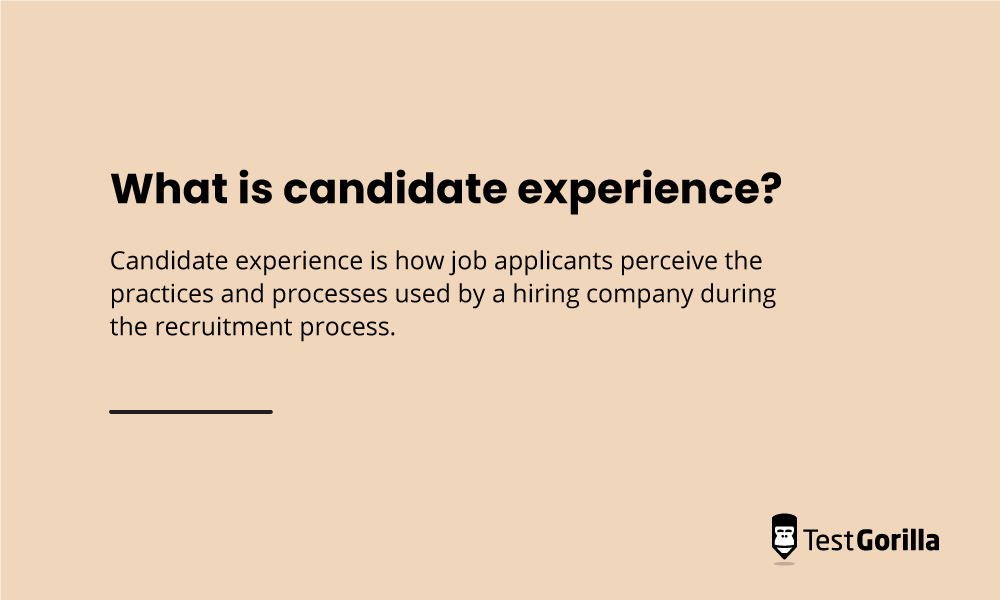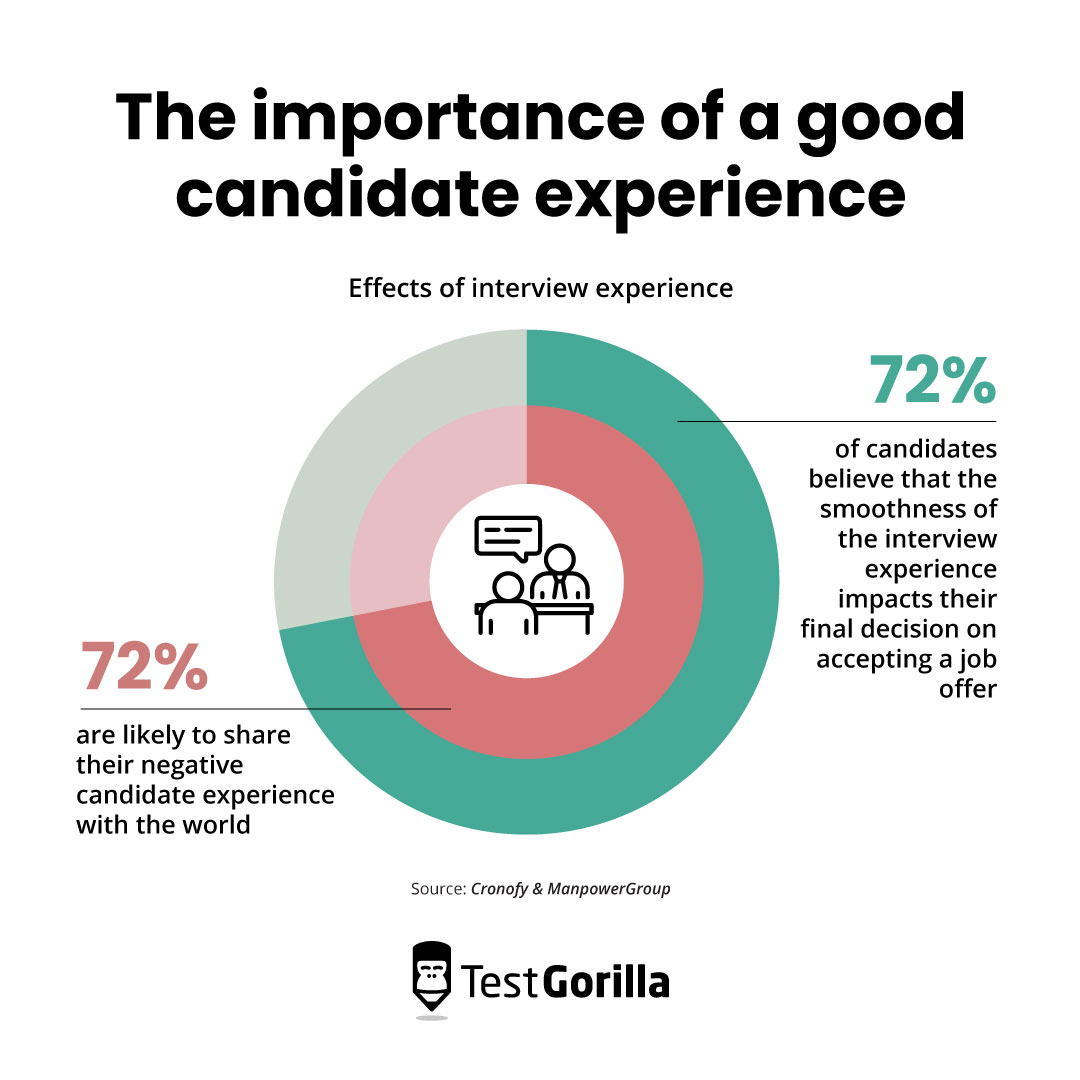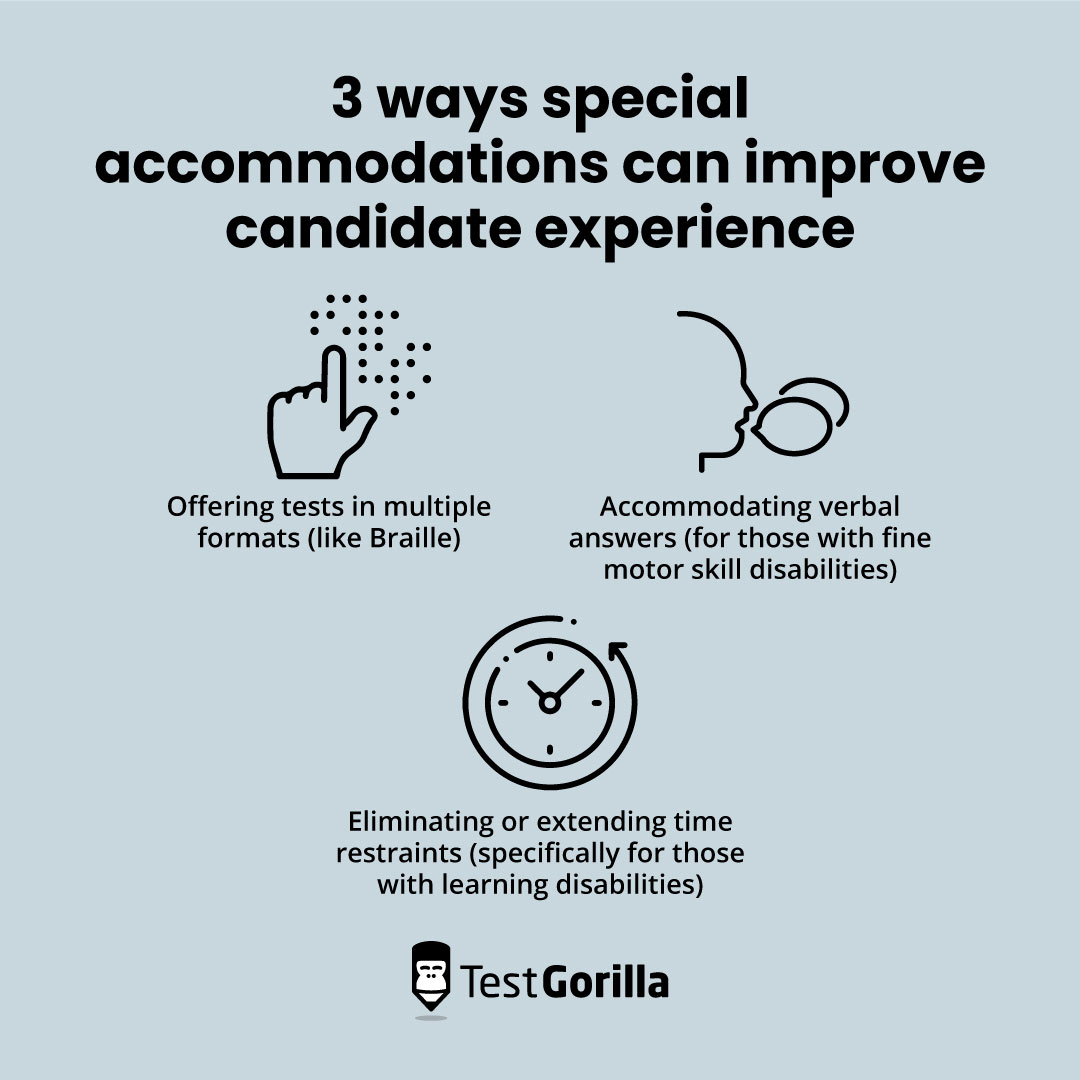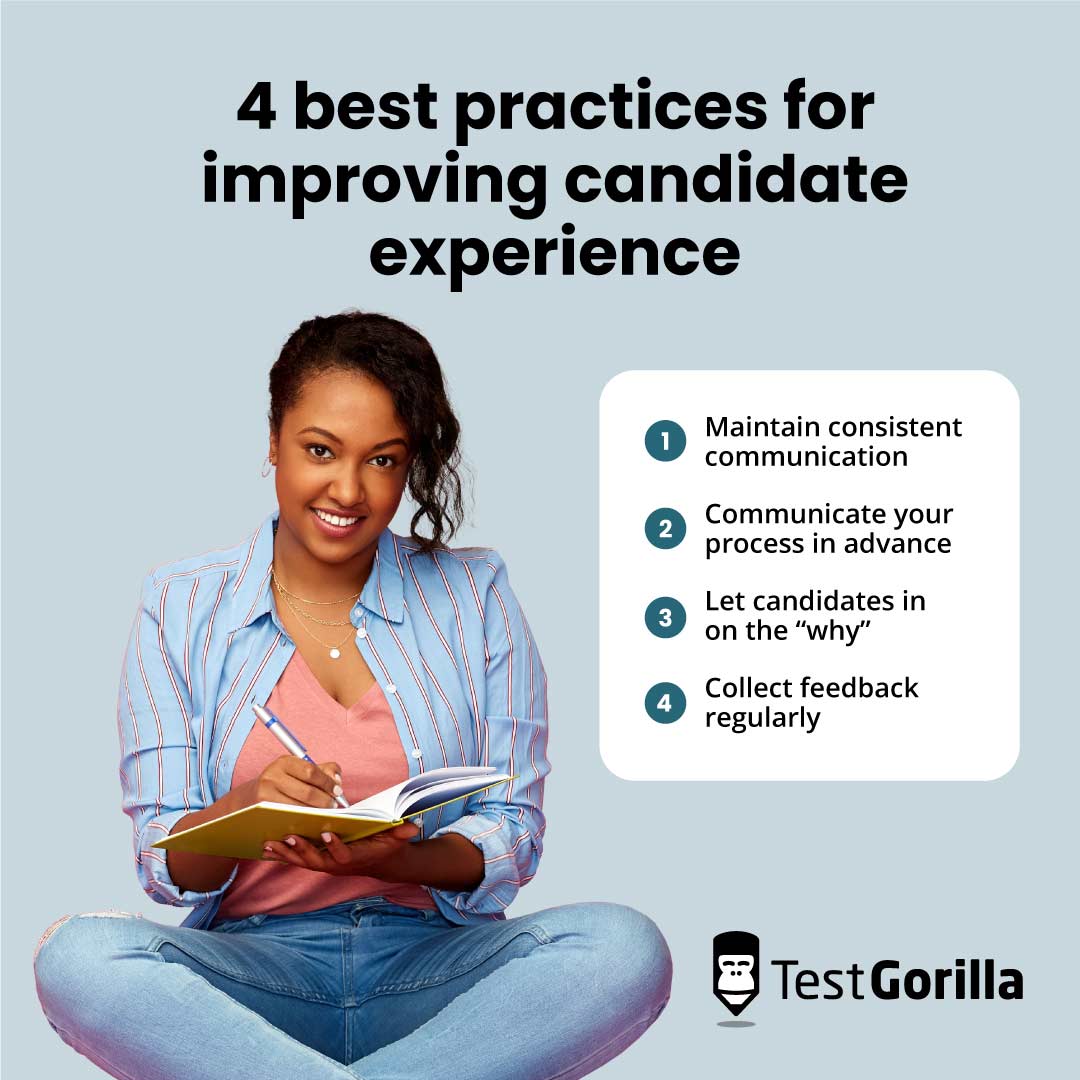Improve candidate experience: How talent assessments help both applicants and recruiters win
Recruiters and hiring managers are forever looking for new opportunities to attract the best talent and plug gaps in their workforce.
Talent shortages are rampant, and since businesses can’t operate effectively without people in the right roles, the hiring process is often rushed or disconnected, leaving a poor taste in the candidates’ mouths.
A poor candidate experience can lead to applicants dropping out of the hiring process, writing bad company reviews, and not even considering reapplying in the future.
So, it’s critical to make sure potential employees have a positive experience – and talent assessments can help.
In this guide, we’re going to explore how skills assessments (like evaluating a candidate’s knowledge of healthcare data security via a HIPAA test) can improve the candidate experience and deliver better results for hiring managers.
Of organizations that implement talent assessments as part of a skills-based hiring approach, 88% see a reduction in mis-hires, and more than half of employees prefer hiring processes that include such assessments.
It’s a win-win.
First, though, we’re going to start with a bit of background info on what the candidate experience actually is and the common issues we see here time and time again.
Table of contents
- What is candidate experience?
- The difficulties with improving the candidate experience
- How talent assessments help make a better candidate experience
- 6 ways to use talent assessments to improve candidate experience
- Beyond talent assessments: 4 best practices to remember for improving candidate experience
- Improving candidate experience is a continuous process
What is candidate experience?
Candidate experience is how job applicants perceive the practices and processes used by a hiring company during the recruitment process.
It includes their experience at every stage of the hiring cycle, from the job posting and interview process all the way to the first day of onboarding and training procedures.
When 92% of applicants report quitting out of lengthy or overly complex job applications (not to mention processes), it's clear that the candidate experience needs some serious attention.
The importance of a good candidate experience
We’re firm believers that hard numbers paint an important story about the state of hiring.
With that in mind, let’s see what the stats about overall candidate experience have to say about the need for most companies to improve.
To start, 72% of candidates believe that the smoothness of the interview experience (which includes everything from the initial invitation through the follow-up) impacts their final decision on accepting a job offer.[1]
In other words, a bad candidate experience at the interview stage can lead to an applicant turning you down.
And when candidates do have a bad experience, 72% of them are likely to share their negative candidate experience with the world, impacting your employer brand and ability to attract quality candidates in the future.[2]
That’s not ideal when 77% of employers worldwide say they struggle to find the skilled talent they require amid a global skills shortage.[3]
Having a great candidate experience can be a useful way to help fill the talent gap.
When these improvements extend to the onboarding process (the last stage in the candidate experience), companies report:
82% improvement in retention rate
70% productivity increase [4]
Take LILAB, who lifted retention by 90% after implementing talent assessments, as the proof in the pudding.
What is a bad candidate experience that needs improving?
A major part of improving the candidate experience is simply avoiding the pitfalls that often contribute to a bad experience.
Here are some of the most common examples of complaints that applicants have with hiring processes:
Common complaint | Example |
Poor communication | When the recruiter says you’ll hear back in a week, but you never do |
Unnecessary requirements | When a college degree or previous experience is required for an entry-level position |
Disjointed or unclear processes | When the hiring manager can’t clearly describe what the next step is after an interview |
Undefined ideal candidate | When the candidate must attend multiple interviews because the hiring company hasn’t established its hiring needs and isn’t sure how to assess applicants against objective criteria |
No clarity around pay expectations | When the applicant passes through the whole process only for the salary offer to be far lower than anticipated because a prior discussion was avoided |
Poor or non-existent onboarding process | When the candidate lands the job but there’s no formal introduction process, or they are “buddied up” with an existing employee without clear expectations of what this process should involve |
Worst of all is when the job description is not clearly defined or when what the hiring manager says in the interview doesn’t match the job ad – 27% of people say that the most frustrating aspect of a job search is deceiving job descriptions.[5]
Clearly, there’s a lot to improve upon. But if creating the perfect candidate experience was easy, we’d all have done it by now.
So, what’s getting in the way?
The difficulties with improving the candidate experience
Let’s be real here.
We are well into the 2020s now, and traditional hiring team methods and HR business-as-usual practices aren’t cutting it anymore.
Multiple interview stages with various stakeholders aren’t giving you more insights; they’re just making for lengthy and cumbersome candidate experiences and adding more interview bias to the mix at each step.
But there are a couple of other things getting in the way of improving candidate experience.
1. You don’t know what’s wrong with your hiring process
The first issue is that many companies don't know what bottlenecks exist in the hiring cycle or what candidates don't like about the process.
The truth is, they’ve never asked!
The solution: Your first step to creating a better candidate experience is simply paying attention and finding out what’s wrong from the candidate’s perspective.
2. You’re making ad-hoc changes
The second issue at play is that many companies only look to improve one or two things without looking at the whole picture.
They might decide, for example, to integrate an ATS (applicant tracking system) to add a bit of objectivity to resume evaluation without actually investigating whether resumes should be part of the process at all.
The solution: Rather than creating ad-hoc changes, implement a total overhaul of the entire candidate journey, with a focus on improving experience. We’ll discuss shortly how to use talent assessments as the driving force for this change.
3. You’re using outdated hiring methods
Finally, there are all those legacy tools and processes that impede candidate experience and create unnecessary roadblocks to landing the perfect new hire.
Outdated technology, like application forms that aren’t mobile responsive, is a classic example (a no-no when 67% of applicants use mobile devices to apply for jobs).
Old-fashioned hiring procedures, like unstructured interviews, are even worse and are a key source of bias in hiring.
The solution: Eliminate outdated, ineffective, and biased practices (like traditional interviews and resumes) in favor of objective talent assessments.
How talent assessments help make a better candidate experience
Most companies can take several important steps to improve candidate experience.
We believe, however, that for the majority of organizations, implementing talent assessments is the first and most critical step to take.
Take Bain & Company, a global consultancy with 59 offices in 37 countries. Bain & Company used TestGorilla’s expansive talent assessment library as the key lever in improving candidate experience.
Eveline Offermans, the recruiting manager, receives about 800 applications for each junior position and upwards of 1,300 when hiring executives.
Trying to get through 40-50 resumes a week meant that applicants were waiting a long time to hear back.
By implementing 10-minute talent assessments at the top of the hiring funnel (with custom branding and easily accessible links for a smooth applicant experience), Eveline could see all of the candidates ranked in order of their skills and shortlist much more effectively.
But talent assessments aren’t only about hiring efficiency and improving candidates’ time spent waiting to hear back.
They can improve the candidate experience by reducing bias and improving inclusivity:
73% of candidates say they want a fair, inclusive system
Deloitte data demonstrate that a skill-based hiring approach makes companies 47% more likely to foster an inclusive work environment
Talent assessments also help organizations stop putting so much emphasis on aspects like background, education, and connections, which have been shown to be far less predictive of on-the-job success than a work sample or assessment.[6]
Moreover, there is an across-the-board move to rely less on college degrees. As Harvard Business Review notes, from 2017 to 2019, employers dropped degree requirements for 46% of middle-skill positions.
Even the public sector is making huge changes, with the state of Maryland cutting degree requirements for nearly half of its available positions.
Talent assessments are a more effective and reliable pre-employment screening tool than degrees, which, excluding obvious circumstances like medical positions, are often unnecessary requirements.
By removing degree requirements when they’re not needed, you increase your talent pool and improve the candidate experience by getting rid of unnecessary hurdles.
Oh, and if all of that wasn’t enough, talent assessments are also more cost-effective.
Our most recent State of Skills-Based Hiring report found that 74% of employers reduced cost-to-hire when using skills-based hiring.
6 ways to use talent assessments to improve candidate experience
It’s pretty obvious that talent assessments can be a theoretical game-changer when it comes to improving the candidate experience.
Let’s now turn our attention to the practical, diving into six powerful ways you can use talent assessments to create a more desirable hiring process and hire top talent.
6 strategies for integrating talent assessments into the hiring process
Strategy | Description |
1. Assess candidates with talent assessments to show you value fair hiring | Talent assessments help promote fair hiring practices and put job candidates’ minds at ease |
2. Use talent assessments to build better job descriptions | Test current employees to establish a benchmark and define expectations that you communicate explicitly in job descriptions |
3. Use situational judgment assessments and structured interviews | Retain some of the face-to-face human element of the traditional hiring process and show applicants you value situational decision-making abilities as well as hard skills |
4. Offer candidates special accommodations | Special accommodations, such as additional test formats or the ability to answer questions verbally, can improve the experience of candidates with disabilities |
5. Integrate talent assessments into the onboarding process | Gamify the onboarding process by providing opportunities for new employees to retest and understand how they’re progressing. |
6. Use the results from talent assessments to recommend a better role fit | By recommending more appropriate roles, you can turn a “No” into a “How about…” |
1. Assess candidates with talent assessments to show you value fair hiring
Many candidates want a fair, inclusive hiring process.
They want to know that their application will be assessed on the grounds of their merit and fitness for the job and not adversely impacted by the various unconscious interviewer biases (like those related to accents or physical attractiveness).
Talent assessments eliminate such biases and promote fair hiring practices by providing an objective standard by which all applicants are assessed.
The test results can’t be inadvertently affected by an applicant’s height or a brand-name college.
The simple use of talent assessments themselves demonstrates your commitment to fair hiring practices, though you can go a step further by using tests specifically designed to improve fairness.
For example, TestGorilla’s culture add test explicitly combats the concept of “cultural fit” – which, more often than not, translates to “Would I go for a beer with this person?”
Instead, it emphasizes alignment in the candidate’s behaviors and company values while favoring unique ideas and perspectives that advance company culture.
2. Use talent assessments to build better job descriptions
Candidates should know what to expect out of the company and role.
Using talent assessments to describe the skills and traits necessary for the role helps build better job descriptions, solving one of the key complaints about candidate experiences.
First, you create benchmarks by testing your current employees.
For instance, if you’re hiring for a sales position, you might combine our B2B Lead Generation test with our Salesforce test to create benchmarks for the hard skills necessary to succeed in the role.
This enables you to set standards for applicant success (and identify high-potential employees who score well), which you can explicitly include in your job descriptions on your careers page.
For example, rather than broadly stating that “experience using Salesforce” is necessary, you might instead outline the specific Salesforce skills you’re looking for, such as:
Lead capture and qualification
Lead structure and setup
Reporting
Managing opportunities through tracking, forecasting, and pipeline management
3. Use situational judgment assessments and structured interviews
Not every aspect of an applicant’s capabilities can be captured by static skills tests.
Much of what the best candidate brings to the table is situational. That is, how they respond and act in certain situations.
Including situational judgment tests, a form of assessment that shows how an applicant might respond in certain on-the-job scenarios, is an effective way to show potential employees that you value not only their hard skills but also their flexibility and problem-solving abilities.
Structured interviews are an alternative option in which you can ask situational questions to achieve a similar end. They are found to be more reliable predictors of workplace success than unstructured interviews.[7]
A structured interview differs from a standard, unstructured interview in a few key ways:
Questions and criteria for good answers are determined in advance
All applicants are asked the same interview questions
Responses are scored objectively against the predetermined success criteria
Using structured interviews can be a good tactic for keeping the face-to-face human element in the hiring process, preventing the feeling of alienation that some applicants may experience from a purely assessment-based process.
4. Offer candidates special accommodations
Talent assessments help to increase diversity in and of themselves. An SHRM survey found that when companies implement skills-based hiring practices, 23% of them see an increase in candidate diversity.[8]
However, more can be done to ensure that people with disabilities are offered special accommodations during the skills testing process. For example:
Offering tests in multiple formats (like Braille)
Accommodating verbal answers (for those with fine motor skill disabilities)
Eliminating or extending time restraints (specifically for those with learning disabilities like dyslexia who may require additional time)
5. Integrate talent assessments into the onboarding process
The final component of the candidate experience takes place once the applicant has landed the role: new employee onboarding.
Talent assessments can be used to gamify this first step in the employee’s training and development and to help them gauge how close they are to becoming fully competent and ready to work autonomously.
Say, for example, that the role you’re hiring for requires heavy use of generative AI, like ChatGPT.
You might use our Working with Generative AI test not only to establish a baseline during the job application process but also to monitor progress throughout onboarding.
The new employee can see themselves advance and progress each time they take the test and score a more impressive result.
6. Use the results from talent assessments to recommend a better role fit
Not every applicant is going to be a great fit for the role they’ve applied for (after all, only one can actually get the job).
But that doesn’t mean they might not be ideal for another role.
The results of your talent assessments help you improve the candidate experience by enabling you to recommend a more appropriate position instead of giving applications the message “Sorry, it's a no this time.”
For example, an applicant taking the Front Desk Receptionist test might score well on organizational skills but not be as adept at customer service.
So, you might recommend they apply instead for an internal administrative role.
And even if it’s not a fit right now, you can still keep these insights on file to reach out to potential candidates at a later point, a great strategy for recruiting passive candidates.
Beyond talent assessments: 4 best practices to remember for improving candidate experience
We know you’re eager to put those six strategies for improving the candidate experience into practice.
But before you dive in, here are a few final words of advice to bear in mind.
1. Maintain consistent communication
Regular communication is critical for a positive candidate experience.
Few applicants are going to complain that you’ve contacted them too regularly, but we already know many job seekers report that being left in the dark is one of the most frustrating aspects of the application process.
Try to find the right balance between personalized communication and automation.
When you’re dealing with hundreds of applicants, it's impossible to respond to everyone personally. In this case, an automated email template of “We’ve received your application” or “Sorry, you didn’t make this shortlist this time” email is totally fine.
But in other scenarios, the human touch might be a better approach.
For example, if you’ve promised an applicant that you’ll get back to them in a week, but internal delays or approvals have put a delay on that plan, a quick, personalized note would go a long way – even if it’s a simple email or LinkedIn message.
2. Communicate your process in advance
One of the best ways to improve the quality of your candidate experience is to set the right expectations upfront.
Once an applicant has been shortlisted, it's a good practice to provide them with a quick rundown of what the process will look like going forward.
This can be in a short list form, such as:
Online talent assessment
Interview with the hiring manager
Interview with CEO
Final decision by [date]
Contract sent
This minimizes the number of “What’s next?” emails and texts you receive and prevent candidates from feeling like they’re in the dark.
3. Let candidates in on the “why”
When candidates don’t fully understand the “why” behind your approach to hiring, they’re less likely to engage with tasks like talent assessments and more likely to form a negative impression.
This is obviously not ideal from the standpoint of improving candidate experience, which is why including a brief explanation of the strategic reasons behind your hiring process is a great practice.
You can package this explanation with the previous step, where you outline every stage of the hiring process to set and align expectations.
4. Collect feedback regularly
This is a critical best practice for improving candidate experience:
Ask for candidate feedback.
If you’re not actively asking applicants about their experience with your hiring processes, any changes you make run the risk of simply being guesswork – or, worse, breaking something that’s already working quite well.
Candidate experience surveys are a great way to capture feedback at scale. Supplement these with personal calls (with applicants who made it through to the interview stage) to dig into more qualitative questions with longer-form answers.
Improving candidate experience is a continuous process
There are a number of tactics and strategies companies can implement to improve the experience candidates have when applying for an open position.
But whether you’re hiring interns or senior managers, implementing talent assessments is sure to be a key recruiting strategy not only for designing a smooth hiring process but for reducing hiring costs and avoiding mis-hires.
From the candidate’s perspective, skills-based hiring is a more accurate, transparent, and fair approach than traditional resume-based processes.
Next, take a moment to explore our test library and find talent assessments to help your HR teams make smarter hiring decisions and reduce the overall cost of recruiting.
Sources
“Candidate Expectations Report 2023: Interview Scheduling: Candidate expectations, frustrations, and preferences”. (2023). Cronofy. Retrieved November 24, 2023. https://www.cronofy.com/reports/candidate-expectations-report-2023
David, Tallulah. (2016). “23 Surprising Stats on Candidate Experience – Infographic”. CareerArc. Retrieved November 24, 2023. https://www.careerarc.com/blog/candidate-experience-study-infographic/
“2023 Global Talent Shortage”. (2023). ManpowerGroup. Retrieved November 24, 2023. https://go.manpowergroup.com/hubfs/MPG_TS_2023_Infographic_FINAL.pdf
Laurano, Madeline. (August 2014). “The True Cost of a Bad Hire”. Brandon Hall Group. Retrieved November 24, 2023.https://b2b-assets.glassdoor.com/the-true-cost-of-a-bad-hire.pdf
“2022 Job Seeker Nation Report: Dynamic Motivations of Modern Workers”. (March 25, 2022). Employ Inc. Retrieved November 24, 2023.https://www.jobvite.com/wp-content/uploads/2022/03/JSN-2022-3-25.pdf
Schmidt, Frank; Oh, In-Sue; Shaffer, Jonathan. (October 2016). “The Validity and Utility of Selection Methods in Personnel Psychology: Practical and Theoretical Implications of 100 Years of Research Findings”. ResearchGate. Retrieved November 24, 2023. https://home.ubalt.edu/tmitch/645/session%204/Schmidt%20&%20Oh%20validity%20and%20util%20100%20yrs%20of%20research%20Wk%20PPR%202016.pdf
Axelson, Rick, et al. (October 2010). “Medical school preadmission interviews: are structured interviews more reliable than unstructured interviews?”. Teach Learn Med. Retrieved November 24, 2023.https://pubmed.ncbi.nlm.nih.gov/20936568/
Maurer, Roy. (August 31, 2022). “Using Skills Assessments Over Education, Experience Requirements”. SHRM. Retrieved November 24, 2023. https://www.shrm.org/resourcesandtools/hr-topics/talent-acquisition/pages/using-skills-assessments-over-education-experience-requirements.aspx
Related posts
You've scrolled this far
Why not try TestGorilla for free, and see what happens when you put skills first.
Latest posts
The best advice on pre-employment testing, in your inbox.
No spam. Unsubscribe at any time.

Hire the best. No bias. No stress.
Our screening tests identify the best candidates and make your hiring decisions faster, easier, and bias-free.
Free resources
This checklist covers key features you should look for when choosing a skills testing platform
This resource will help you develop an onboarding checklist for new hires.
How to assess your candidates' attention to detail.
Learn how to get human resources certified through HRCI or SHRM.
Learn how you can improve the level of talent at your company.
Learn how CapitalT reduced hiring bias with online skills assessments.
Learn how to make the resume process more efficient and more effective.
Improve your hiring strategy with these 7 critical recruitment metrics.
Learn how Sukhi decreased time spent reviewing resumes by 83%!
Hire more efficiently with these hacks that 99% of recruiters aren't using.
Make a business case for diversity and inclusion initiatives with this data.






















